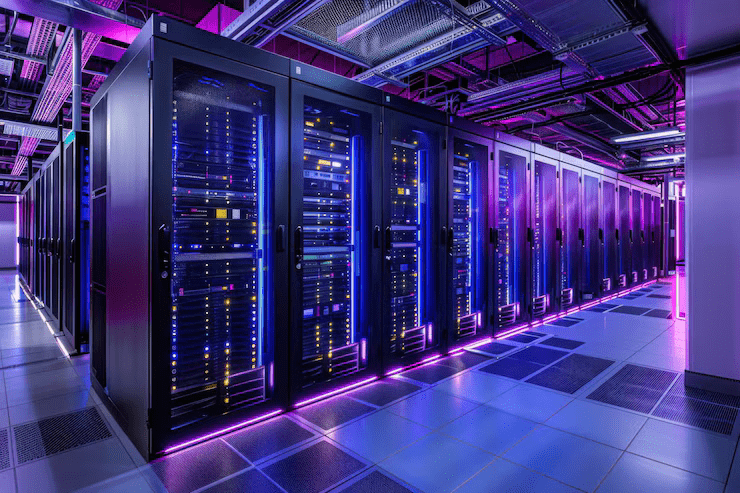In this time of closely linked online world, the need for strong network security is more important than ever. For companies of all kinds, the ability to keep private information safe and uphold the honesty of their networks is key. As our reliance on digital systems increases, so does the risk area, where cybercriminals often come up with fresh ways to break into network security systems. In response, network security has changed into a tricky, multilayered field — a main part of any organization's IT plan that protects against wrong-access data theft and possible attacks.
Network security is a defense in-depth approach, which comprises several high-end tools as well as coaxing strategies. Firewalls, encryption, behavior analytics, and access controls basically fall into a broad arena of network security practices and technologies. Rather, these factors work together to enforce the security of information, resources, and critical systems from unauthorized access, misuse of information, and cyber threats. For various companies, such strategies involve the use of customized network security management practices for certain specifications, which add flexibility and resilience against sudden vulnerabilities.
Let’s learn what makes network security such an important element of any digital business in this detailed guide. We’ll understand and talk about different network security solutions, computer network security within network security models, and why these controls are critical to maintain network information security (in large organizations). Whether it’s simple firewalls or enterprise network security, knowing these will give you a great foundation to secure your network.
What is Network Security?
Network security is a group of technologies and protocols, which are designed to keep data and resources safe, secure and accessible on a computer network. Security of the network is a fundamental part of all modern digital systems — from stopping access by malicious attackers to ensuring that data is not compromised. It is designed to build a secure layer over confidential information, assets, and the whole network information security environment within which a company does its business.
We live in an era of connected businesses and small start-ups as well as big enterprises that need to communicate, store and analyze terabytes of data with each other. That’s why the need for a trusted network security system has increased. It is not just that this framework prevents attacks from the outside but also safeguards internal operations against any kind of misuse or loss.
Effective network security solutions go beyond basic firewall and antivirus setups; they incorporate advanced network security management strategies, integrating network security tools like intrusion detection systems, encryption, and multi-factor authentication. Network security goes beyond averting any breaches because these solutions are designed to thwart ever evolving complex threats, it is about the preservation of the reliability and the credibility of the network environment of an organization.
Currently, small, medium and large scale businesses should all view full network security as a priority. Ensure that business customers, company and operational sensitive information is safeguarded, so a company can think of expanding and developing instead of worrying about online threats. Contemporary enterprise network security systems give solutions that are adjustable and modifying in relation to the security threats in the environment, cut across the ordinary protections.
Utilizing simply the basic firewall and antivirus setup is inadequate as far as effective network security measures are concerned. They address sophisticated network security maintenance procedures and include cross border facilities such as encryption, multi-factor authentication as well as intrusion detection systems. It is precisely because these solutions are specifically designed to address more intricate solutions that network security is required to not only avert future illicit access to the system, but also to protect and safeguard the reputation and integrity of the organization’s network environment.
Whether small, medium or large tall, all businesses have to protect their investments by securing the computer network systems. Strong network security measures shield corporate secrets, privileged information and even operational information. Businesses can now focus on growth and development rather than thinking about the online threats. Today’s fact is that the modern enterprise network security systems have unique solutions and good scalability to conform to the threat.
Types of Network Security
Network security is not a single solution, but rather a collection of several technologies and strategies. The following important network security categories should be taken into account by any company:
- Firewalls: As the initial line of protection, firewalls keep an eye on and regulate all network traffic, both inbound and outbound. A firewall implements a predetermined set of rules to keep out unwanted external access and make sure that only information that is permitted is delivered out of the network.
- Intrusion Detection and Prevention Systems (IDPS): According to the core meaning of intrusion detection and intrusion prevention systems, they inhibit and warn any potential harmful act inside the network. They are also useful in pinging the authorities when their observation algorithms flag any strange activity that could be a threat.
- Antivirus and Anti-malware Software: Such software ensures that network assets are not infected with viruses and malicious programs by network security devices. They are also useful in protecting the integrity of resources on the network through consistent virus detection.
- Virtual Private Networks (VPNs): VPNs support the users to get access to networks even in remote locations through a secured and encrypted communication link over the internet. VPNs are very important for the protection of corporate networks in the context of increasing remote working arrangements.
- Access Control: At the level of the network, a strong protection in terms of control over access ensures that users who are authorized are the only ones who can access the sensitive information contained on the network. Companies that implement strict access controls can prevent unauthorized access to critical systems.
- Email Security Solutions: Email is still a common entry point for cyberattacks. Email security solutions protect networks by eliminating message attachments, links, and other potentially harmful content.
Network security, in its various forms, can be made more effective through integration, as this adds another layer to the existing defense architecture.
The Role of Network Security in Networking
Networking in Network Security has a very crucial role to play. Organizations incorporate it to avoid dangers of unwanted breaches and attacks on their data and these protocols of Network Security are considered to be a very skilled interconnected solution. Creating a secure environment where data can flow freely and systems can function without the fear of threats is a key objective of network security. This security outline is very important for the purpose of providing security of information, maintenance of business continuity, and maintenance of trust in a business’s digital infrastructure between business and its partners and customers.
This is because there have been rapid changes in the digital environment and the current systems have integrated cloud computing, mobile technologies, and Internet of Things (IoT) devices to form more complex networks. This advancement, besides opening new opportunities that never existed before, also leads to new threats that put computer networks to various risks that could compromise the integrity of data within the networks or disrupt normal operations. Because of the many facets and protocols of the proactive security methods that are employed by these defense systems, organizations help themselves from the threats of exposure as it is tremendously lowered. Hence, strong network security systems have now become one of the key requirements.
Beyond merely blocking any unwanted access, any well-established network security system erects a dynamic barrier surrounding the network that adapts to potential vulnerabilities as a result of the constant data interchange between devices and applications. Network security solutions, such as intrusion detection systems, firewalls, and encryption algorithms provide monitoring proficiencies as well as real-time security. By implementing and incorporating these methods in the functions, businesses support their work as it improves the network security considerably and protects sensitive data and stops unauthorized access.
Strategic network security solutions are progressively dynamic as establishments adjust to the developing digital landscape. The amalgamation of IoT, cloud technology, and interoperable systems allows organizations to oversee these tools without compromising strict security measures. Considering the fact that an enterprise has to deal with massive amounts of data, manage access to various devices and address and handle increasingly sophisticated cyber threats, a powerful and all encompassing security architecture is critical. Consequently, network security is not just advantageous but also crucial for organizational agility and the safe, efficient operation of digital environments.
Key Elements of a Network Security System
Every component and means within a strong network security framework is planned to defend numerous aspects of the network. Some central components contain:
- Encryption: This procedure safeguards data by altering it into a coded format that doesn’t allow anyone to decipher by illegal means. It is important for preserving data privacy and plays a serious part in protection of network information.
- Network Access Control (NAC): NAC’s purposes ensure that only verified people and devices can access the network, by this means diminishing the risk of unauthorized access becomes achievable.
- Application Security: The practice of application security involves protecting network-based applications by identifying and rectifying vulnerabilities that could be exploited by malicious actors.
- Behavioral Analytics: This refers to systems that leverage artificial intelligence and machine learning to identify atypical network behavior that may indicate a security vulnerability.
- Data Loss Prevention (DLP): DLP resolutions are precisely planned to avoid data breaches and to safeguard sensitive information and make certain that it does not accidentally exit the network.
- Web Security: Web security is attentive towards monitoring and straining incoming web traffic to counter online threats and limiting access to damaging websites.
Each of these components is needed for guarding networks from probable risks. Collected, they create a system that is a comprehensive network security framework that delivers numerous layers of protection.
Network Security Tools and Solutions
The businesses of Pakistan that are constantly striving to achieve technological edge in their functions are putting a lot of effort into placing Network Security protocols to identify, monitor and eliminate cyberthreats. As much as the recent times have shown that digital threats are becoming the biggest dangers, businesses are looking for more multi-layered yet simplified ways of Network Security. In this regard, Next-generation firewalls outshine due to their simple features, which enable them to identify and thwart intricate online threats. This helps achieve capabilities like threat intelligence integration and deep packet inspection. There are other methods like Wireshark, SolarWinds, and Nagios which are instances of network monitoring tools that help administrators to read the network traffic and pick out any unusual patterns that might possibly point to potential threats. Likewise, Unified Threat Management (UTM) solutions support an entire security architecture by combining firewalls, VPNs, content filtering, and antivirus software into a single, integrated solution.
On the other hand, Intrusion detection and prevention systems (IDPS) that are constructed and incorporated by organizations are to stop unwanted access attempts and identify questionable activity throughout the network. In this system, they are the essential tools not to be missed out on. Also, it is very crucial to not overlook data encryption methods that can include SSL/TLS. These tools are critical for data security and privacy during transmission or broadcast. Thus, when an organization is implementing these, they must develop a potent, multi-layered security plan. Once everything is in place as discussed, the organization will be able to develop a very strong and dynamic network security plan that can fight any major cyberthreats and minimize the chances of dangers and help run the business smoothly.
Enterprise Network Security: Protecting Large-Scale Environments
Enterprise network security is considered as one of the most complex security methods by companies. The reason behind it is its broad complexity in implementing and executing. In order for companies to take full advantage of this system, here are some strategies that can come in handy.
Among the crucial elements of protecting a company network are:
- Centralized Security Management: By having a unified and a less complicated system to manage network security simplifies monitoring, incident response, and policy enforcement.
- Endpoint Security: The devices that are connected with an organization's various system networks have the highest possibility of risks. Therefore, Endpoint security helps make things so certain that companies know their data will be highly guarded.
- Network Security as a Service (NSaaS): Many organizations opt for this method to partner with a third-party vendor for network security management. Scalable NSaaS solutions enable companies to access expert security services without the need for a large internal team.
- Identity and Access Management (IAM): These programs limit authorized person’s access to private data on a network, reducing absolutely any kinds of dangers of unwanted access.
By offering customized strategies tailored to the specific needs of large enterprises, enterprise network security solutions ensure the protection of various networked devices and data.
Network Security Management: Best Practices for Businesses
Effective network security management requires continuous monitoring, evaluation, and change to security measures. Adopting best practices for businesses in Pakistan can greatly improve the security of digital assets. Regular security audits are critical to identifying and fixing potential vulnerabilities before they become a problem. Human error remains the leading cause of security breaches. Therefore, employee training is also important. Businesses can reduce the chance of a breach or accidental data leak by training employees on cybersecurity best practices. Adding multi-factor authentication (MFA) adds an additional layer of security. Thus, this process ensures that no unwanted threats or access takes place by any means in the systems.
In order to eliminate any kind of chances of vulnerabilities organizations must take the methods of patch management seriously and ensure it with regular hardware and software updates. Moreover, to prevent and restrict any breaches in the system, it is important to understand and precisely define the incident response plan. By doing so, organizations will ensure and detect early dangers that even try to enter the system. By following these best practices, the organizations of Pakistan can create a strong as well as flexible network security management system. This protects their business functions from the constantly changing cyber threat environment.
Network Security's Future: Adjusting to Emerging Risks
There is an increased need for businesses to adapt their network security measures because cyber threats are changing with technology. For instance, there are several trends that are emerging in network security that will change how we conduct business in the future:
- Use of AI and Machine learning for Security: Unlike the conventional methods where the times of response of threats are often very long, AI-powered security systems are able to monitor and identify threats at real-time using automated algorithms to analyze data.
- A Shift Away from Trust-Based Models: This concept advocates for an approach whereby users and devices are able to log into the network regardless of their location which is intended to reduce the chances of unauthorized access.
- New Forms of Encryption: More sophisticated forms of encryption will have to be developed in future in order to counter the quantum cyberthreats created by developments in quantum computing.
- Solutions for Protecting Cloud Data: Increasingly more firms will become reliant on internet-based servers which will call for particularly designed solutions for protection of cloud data.
In order to keep up with the developments in the cybersecurity industry, a firm should anticipate these trends.
Conclusion
The current competitive environment in which enterprises operate is constantly changing and as such, businesses need to take the necessary precautions to protect their information assets, so network security becomes particularly critical. There are many ways to secure sensitive data and ensure business continuity in the context of accelerating digital transformation. These include using a firewall, virtual private networking (VPN), and fusion of complex advanced network security tools even those with Artificial intelligence aspects to oversee activities and control behaviors over networks.
As a result, the need for thorough network security management has never been greater in the face of the ever-evolving cyber threat landscape. The implementation of strong network security measures aids businesses in maintaining consumer trust and regulatory compliance while working in a safe environment. Enterprise network security offers flexible and in-built reliable architecture tailored to the dynamics of large and complex networking enabling the management of numerous complex interrelationships. In fact, any organization irrespective of its size should have a multifaceted threat adaptation strategy as a minimum standard.
As new technologies emerge as well as the global network being incredibly complex, it is evident that network security is bound to change. Cloud adoption, mobile proliferation and the IOT continue to gain pace with them making digital infrastructures more connected and hence more vulnerable. With the strategic implementation of world class cyber security measures coupled with outsourced network security solutions, organizations can innovate, grow, enhance customer experience and never have trouble dealing with malicious attacks.
For the most rapidly evolving industry in computer science as Cyber Security is, one of the most important aspects is to learn and adapt. Organizations that understand trends in software, systems and architectures and keep up with new developments in encryption protocols, multifactor authentication and others will be in a better position to face threats and protect their assets.







